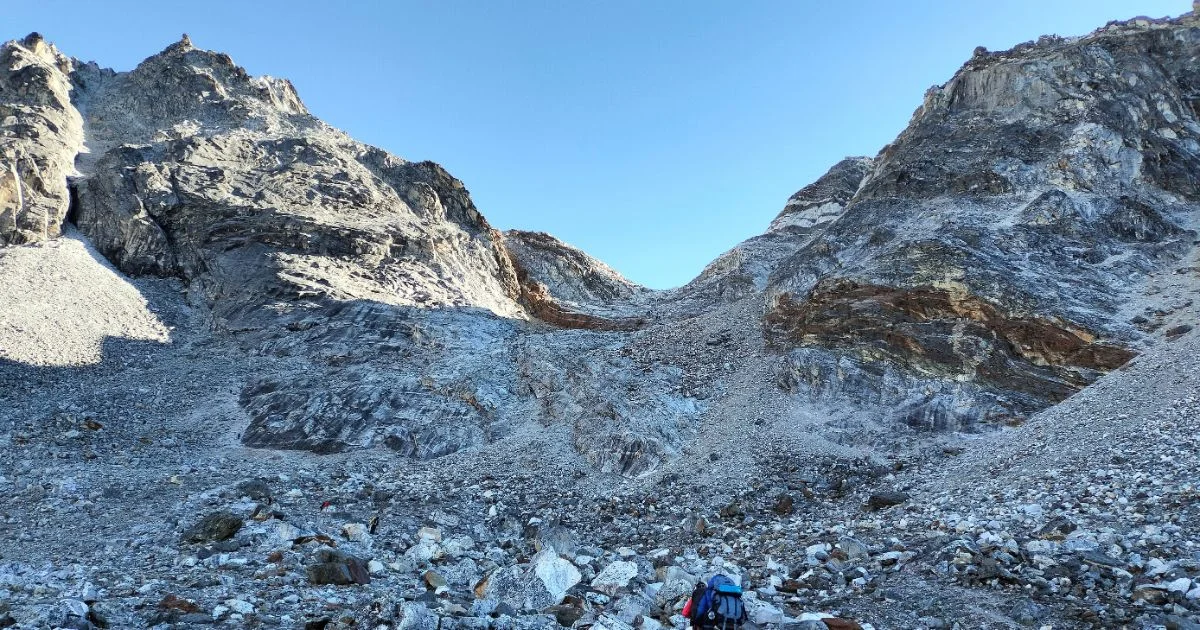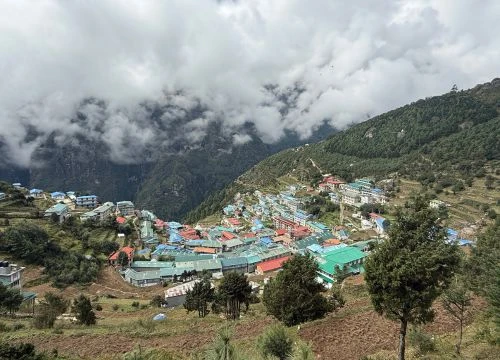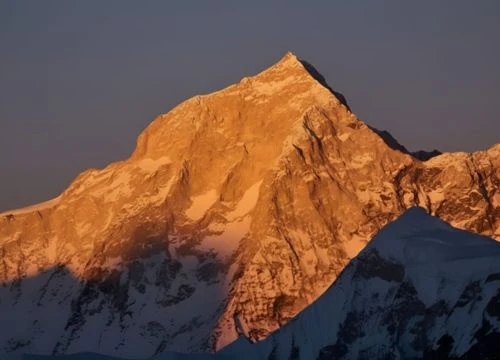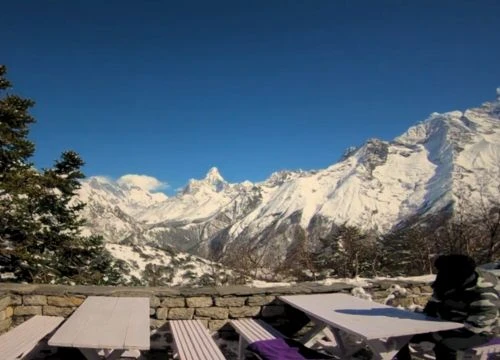Essential Khumbu Glacier Facts
Daily ice movement: - The glacier moves an estimated 0.9 to 1.2 meters down Mount Everest's flank every day, with acceleration through the icefall reaching over 300 meters annually
Ice transit duration: - Ice entering the icefall takes approximately 4.3 years to emerge at the base, demonstrating the complex internal flow dynamics
Surface area coverage: - Spans 45.6 square kilometers with an ablation area of approximately 20 square kilometers below the major icefall
Debris insulation effects: - Thick debris layers (over 20 centimeters) actually slow melting by insulating underlying ice, while thin debris accelerates it by up to 30%
Drainage complexity: - Features both surface braided streams and internal moulin systems (vertical meltwater shafts) that can extend hundreds of meters into the glacier's interior
Icefall dynamics: - Located at 5,486-5,800 meters elevation, the icefall's configuration changes continuously as seracs up to 30 meters high shift and collapse unpredictably
Temperature thresholds: - Above 5,400 meters, temperatures rarely exceed freezing, creating the perpetual winter conditions necessary for ice accumulation
Retreat acceleration: - Current retreat rates average 18 meters annually but vary dramatically (8-35 meters) depending on yearly climate conditions
Water supply contribution: - Provides roughly 40% of downstream flow during peak melt season (May-September), supporting millions across Nepal and northern India
Research accessibility: - Represents one of Earth's most accessible high-altitude glacier systems for scientific study, with ongoing monitoring since 1976
Geological Formation and Evolution
Origins in the Last Ice Age
The Khumbu Glacier's story began roughly 20,000 years ago during the Last Glacial Maximum. As global temperatures plummeted, massive ice sheets accumulated in the Himalayas' highest valleys. The Khumbu valley, carved by millennia of glacial action, became the perfect cradle for this frozen giant.
According to research published in the Journal of Glaciology, unlike typical valley glaciers, the Khumbu formed through a complex process. Snow accumulated year after year in the Western Cwm, a high-altitude basin surrounded by Everest and the Lhotse-Nuptse ridge. This natural amphitheatre acted as a massive snow collector, feeding the glacier below.
Snow Accumulation and Ice Transformation
The transformation from fresh snow to glacial ice takes decades in the Himalayas. Initially, snow compacts into firn - granular snow that survives at least one melt season. Under increasing pressure, air bubbles gradually squeeze out, creating dense, blue glacial ice.
Based on glaciological studies from the Nepal Department of Hydrology and Meteorology, at elevations above 5,400 metres, temperatures rarely rise above freezing. This perpetual winter allows snow to accumulate faster than it melts, creating the positive mass balance necessary for glacier formation. However, recent decades have disrupted this delicate equilibrium.
Tectonic Influences and High-Relief Uplift
The Himalayas continue rising at roughly 4 millimetres annually due to ongoing collision between the Indian and Eurasian plates. This tectonic activity creates the extreme relief necessary for glacier formation - steep gradients that channel snow into narrow valleys where it can accumulate and transform.
Research from the International Centre for Integrated Mountain Development (ICIMOD) shows that the Khumbu region of Nepal's unique geology includes ancient marine sediments thrust skyward, creating the characteristic layered rock formations visible throughout Sagarmatha National Park. These geological processes shaped the glacier's basin and continue influencing its behaviour today.
Historical Expansion and Recession
Evidence from Holocene moraines - rock debris left by advancing glaciers - reveals the Khumbu Glacier once extended much farther down-valley. These ancient terminal moraines, visible near Dingboche and Pheriche, mark maximum glacier positions during cooler periods over the past 11,000 years.
A comprehensive study published in Quaternary Science Reviews using core samples and radiocarbon dating suggests the glacier experienced several advance-retreat cycles, with the most recent significant advance occurring during the Little Ice Age (roughly 1300-1850 CE). Since then, accelerating retreat has become the dominant trend, documented by our team's annual monitoring expeditions.
Physical and Structural Characteristics
Size, Elevation Range, and Flow Dimensions
The Khumbu Glacier stretches approximately 17 kilometres from its source in the Western Cwm to its terminus near Lobuche. This glacier is stretched across 39 to 45 square kilometres, flowing from elevations of 7,600 metres down to 4,900 metres, making it the highest glacier in the world system and the world's highest glacier formation, representing one of Earth's most extreme ice environments, where Mount Everest dominates the surrounding landscape.
Despite its impressive length, the glacier remains relatively narrow - typically 1-2 kilometres wide. This compressed flow creates intense pressure that forms the glacier's most famous feature: the Khumbu Icefall.
The Legendary Khumbu Icefall
Where the glacier spills over a steep rock step between 5,486 and 5,800 metres, it fractures into a chaotic maze of seracs - towering ice blocks that shift constantly. The Khumbu Icefall is one of mountaineering's most challenging obstacles, where these ice towers, some reaching 30 metres high, create a significant challenge for climbers.
The icefall moves roughly one metre daily, meaning its configuration changes continuously. What appears solid in morning photographs may collapse by afternoon, earning it the nickname "the most dangerous part of the glacier in the world".
Debris Cover and Ice Morphology
Unlike pristine glaciers in temperate regions, the Khumbu Glacier carries massive amounts of rock debris. This supraglacial debris - ranging from fine sediment to house-sized boulders - covers roughly 60% of the glacier's lower sections.
This debris layer creates unique ablation patterns. While thin debris accelerates melting by absorbing heat, thick debris (over 20 centimetres) insulates underlying ice, slowing melt rates. This creates the glacier's characteristic hummocky surface of ice mounds separated by debris-filled valleys.
Ice Flow Velocity and Dynamics
Glacier velocity varies dramatically by section. Near the Western Cwm, ice flows roughly 100-150 metres annually. Through the icefall, movement accelerates to over 300 metres yearly due to gravitational forces and compression.
In lower sections, debris cover and reduced gradient slow flow to 20-50 metres annually. However, internal ice flow continues even where surface movement appears minimal, creating complex stress patterns that influence crevasse formation.
Experience the Khumbu Icefall safely with our certified climbing Sherpas!
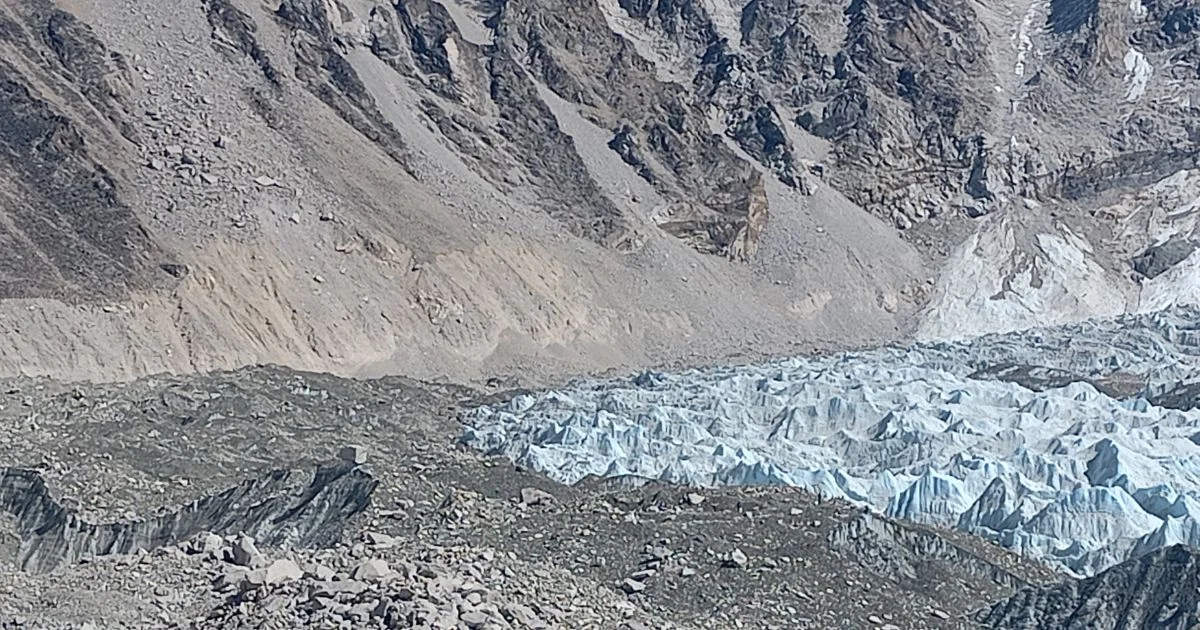
Hydrology and Climate Interactions
Meltwater Contribution to Regional Water Supply
The Khumbu Glacier serves as a critical water tower for the Dudh Koshi River system. During peak melt season (May-September), glacial runoff provides roughly 40% of downstream flow, supporting millions of people across Nepal and northern India.
This meltwater follows complex pathways. Some flows across the glacier surface in braided streams, while other water travels through internal channels called moulins. These vertical shafts, carved by surface meltwater, can extend hundreds of metres into the glacier's interior.
Debris-Mediated Ablation Processes
The glacier's thick debris mantle creates unique melting patterns rarely seen elsewhere. Thin debris layers (1-5 centimetres) increase ablation rates by up to 30% compared to clean ice. However, debris thicker than 20 centimetres reduces melting by insulating underlying ice.
This creates differential ablation - uneven melting that forms the glacier's characteristic rolling topography. Ice beneath thin debris melts rapidly, creating depressions, while thick debris protects ice, forming raised areas called ice pinnacles.
Long-Term Retreat Trends
Since systematic monitoring began in 1976, the Khumbu Glacier has retreated approximately 18 metres annually. However, retreat rates vary significantly year to year, ranging from 8 to 35 metres depending on climate conditions.
Unlike many glaciers that thin uniformly, the Khumbu shows complex patterns. While the terminus retreats, some mid-glacier sections actually thicken due to debris insulation and reduced flow rates. This creates stagnant ice zones where movement becomes minimal.
Climate Change Impacts
Rising temperatures affect the glacier through multiple mechanisms. Increased snowline elevation reduces accumulation zones, while higher melt rates increase ablation. Perhaps most concerning, changing precipitation patterns alter the timing and amount of snow input.
Traditional monsoon patterns that delivered heavy snowfall are becoming less predictable. Some years bring excessive moisture, while others experience drought. This variability makes long-term glacier behaviour increasingly difficult to predict.
Surrounding Landscape and Ecosystem
List of Glaciers Around Khumbu Region of Nepal
Glacier Name | Description |
Khumbu Glacier | The world's highest glacier system flows from 7,600 m to 4,900 m between Mount Everest and the Lhotse-Nuptse ridge. This Khumbu Glacier, Nepal, route is the main access path to Everest Base Camp and includes the notorious Khumbu Icefall. |
Rongbuk Glacier | A massive 22-kilometre glacier located on the northern Tibetan side of Everest. It includes the East and West Rongbuk tributaries and forms part of the largest Everest glacial drainage system in Nepal. |
East Rongbuk Glacier | A key tributary of the Rongbuk system, it flows from Everest’s northeast ridge and glacier and follows the northern climbing route to Advanced Base Camp. |
Kangshung Glacier | Situated on Everest’s eastern face in Tibet, this glacier flows down the Kangshung Face. Known as one of the most difficult climbing approaches to Everest, it is less frequented among glaciers in the Everest region. |
Imja Glacier | Originating from Imja Tse (Island Peak), this glacier has formed the fast-growing Imja Lake - one of the most critical glacier lakes in the Khumbu region - posing GLOF threats to downstream settlements. |
Lhotse Glacier | It descends from Lhotse (8,516 m), the fourth-highest mountain in the world. This glacier feeds into the Western Cwm and eventually merges with the upper Khumbu system. |
Nuptse Glacier | A series of glacier systems flowing from Nuptse (7,861 m), forming dramatic ice cliffs along the Western Cwm. Works alongside Lhotse glaciers to support the greater Khumbu network. |
Changri Nup Glacier | Emerging from Changri Peak’s western side (6,027 m), a key site for debris-covered ice flows, it contributes to the Khumbu Glacier system. |
Changri Shar Glacier | The eastern counterpart to Changri Nup, flowing parallel from Changri peak’s eastern flanks. Highlights the layered, tributary-rich character of glaciers in the Everest region. |
Pumori Glacier | Originating from Lingtren (6,749 m), this glacier supports the northern section of the Khumbu network. Though less researched, it’s part of the largest glacial complex in Nepal, near Everest. |
Lingtren Glacier | Originates from Lingtren (6,749 m), supports the northern Khumbu network, and is part of the largest glacial complex near Everest. |
Khumbutse Glacier | A small but important glacier flowing from Khumbutse (6,640 m), contributing to the intricate web of ice in the upper Khumbu Valley. Like others, this glacier follows a high-altitude, steep path toward the larger Khumbu basin. |
Flora Adapted to Extreme Conditions
Sagarmatha National Park's plant life showcases remarkable adaptation to harsh high-altitude conditions. In lower valleys around Namche Bazaar (3,440 m), blue pine and rhododendron forests create vibrant spring displays. Nepal's national flower, the red rhododendron, blankets hillsides in brilliant crimson during the April-May blooming season.
Above 4,000 metres, vegetation becomes increasingly specialised. Alpine juniper forms prostrate mats, hugging the ground to avoid fierce winds. Hardy cushion plants like Androsace and primula create miniature gardens in rocky crevices, their roots extending deep into stone cracks for stability.
The highest flowering plants on Earth grow within sight of the Khumbu Glacier. Saussurea gossypiphora, a woolly composite, has been found at 6,400 metres - higher than most base camps. These extreme survivors employ fascinating strategies: dense white hairs trap warm air, while antifreeze proteins prevent cellular damage.
Wildlife Thriving in Thin Air
Despite harsh conditions, Sagarmatha National Park supports 118 bird species and 26 mammal species. The elusive snow leopard roams high ridges, though spotting one requires exceptional luck. These ghost cats hunt blue sheep (Pseudois nayaur) and Himalayan tahr across precipitous terrain.
Red pandas inhabit bamboo-rich forests between 2,200 and 4,800 metres. These endangered mammals, unrelated to giant pandas despite their name, represent one of the park's most sought-after wildlife sightings. Their russet fur and masked faces have charmed visitors for decades.
High-altitude birds display remarkable adaptations. The Himalayan monal, Nepal's national bird, sports iridescent plumage that shimmers against snow. Blood pheasants and snow partridges camouflage perfectly among alpine vegetation, while choughs and ravens soar effortlessly at altitudes that would ground most aircraft.
Discover Sagarmatha's incredible biodiversity on our guided nature treks!
Cultural and Spiritual Connection
Sherpa Beliefs and Mountain Reverence
The Sherpa people have lived in harmony with the Khumbu Glacier and surrounding peaks for over 400 years. Known for their mountaineering skills and deep mountain knowledge, their name literally means "people from the east", reflecting migration from Tibet's Kham province. However, their spiritual connection to these mountains in the Mount Everest region runs far deeper than geographical origins.
In Sherpa cosmology, glaciers aren't merely ice formations - they're sacred entities deserving respect and protection. The Khumbu Glacier is considered the dwelling place of protective deities who safeguard the valley. Before any major expedition, Sherpas perform puja ceremonies, seeking permission from mountain spirits and ensuring safe passage.
Traditional Sherpa practices demonstrate profound ecological wisdom. Seasonal grazing patterns prevent overuse of fragile alpine meadows. Sacred groves protect watersheds that feed glacial streams. These customs, passed down through generations, created sustainable mountain communities long before modern conservation concepts emerged.
Buddhist Traditions and Monastery Networks
Tengboche Monastery, perched dramatically at 3,867 metres with views of Everest and the Khumbu Glacier, serves as the Khumbu region's spiritual heart. Founded in 1916, this Tibetan Buddhist gompa hosts ceremonies that blend mountain worship with traditional Buddhist practice.
Every spring, Tengboche hosts the Mani Rimdu festival, where masked dancers perform ancient rituals. These celebrations honour protective deities while blessing climbers and trekkers heading toward Everest. The festival draws Sherpa families from across the Khumbu valley, reinforcing cultural bonds that transcend village boundaries.
Prayer flags flutter throughout the glacier zone, carrying mantras on mountain winds. Chortens (Buddhist stupas) mark sacred sites and safe passage points. These religious structures aren't merely decorative - they represent tangible expressions of spiritual relationships with the landscape.
Glacier's Role in Sherpa Livelihoods
Traditionally, Sherpas relied on yak herding and trans-Himalayan trade for survival. Glacial meltwater supported summer pastures in the lower Khumbu valley where yaks grazed, providing milk, meat, and wool. Trade routes crossed glacial valleys, connecting Tibet with lower Nepal through high passes.
Modern mountaineering tourism has transformed the Sherpa economy while maintaining cultural connections to the glacier. Many Sherpas work as climbing guides, porters, and teahouse operators, sharing their mountain knowledge with international visitors. This economic shift brought prosperity but also new challenges to traditional lifestyles.
Climate change now threatens these cultural connections. Traditional seasonal patterns are impacted by unpredictable glacier behaviour. Some sacred sites become inaccessible as ice formations change. Sherpa elders worry that younger generations may lose spiritual connections to landscapes their ancestors revered.
Traditional customs are still followed by many Sherpa families in spite of the pressures of modernisation. They still perform glacier blessing ceremonies, maintain sacred sites, and teach children about respectful mountain relationships. This cultural resilience offers hope for preserving both Sherpa heritage and glacier conservation.
Scientific Research and Monitoring
Pioneering Ice-Core Research
Scientists have extracted ice cores from the Khumbu Glacier and nearby ice fields since the 1970s, creating climate records spanning thousands of years. These frozen archives preserve atmospheric conditions, including temperature variations, precipitation patterns, and even ancient air bubbles containing prehistoric atmospheres.
Research teams from Nepal, Japan, and the United States collaborate on glacier monitoring programmes. The Ice, Cloud, and land Elevation Satellite (ICESat) provides precise elevation measurements, tracking how glacier thickness changes over time. Ground-based studies complement satellite data with detailed surface observations.
Mass Balance and Debris Studies
Understanding how debris affects glacier behaviour represents cutting-edge glaciology. Researchers study debris thermal properties, measuring how different rock types and thicknesses influence melting rates. This research helps predict future glacier behaviour under various climate scenarios.
Ablation stake networks across the glacier surface provide precise melt measurements. Scientists drill aluminium poles into the ice, then monitor how much ice melts around each stake over time. This data reveals complex patterns of glacier thinning and thickening.
Paleoclimate Records from Moraine Dating
Cosmogenic radiocarbon dating of ancient moraines reveals glacier history over millennia. When glaciers advance, they push rock debris into terminal moraines. By measuring cosmic ray exposure in these rocks, scientists determine when glaciers reached maximum positions.
These studies show the Khumbu Glacier expanded significantly during cooler periods over the past 10,000 years. The most recent major advance occurred during the Little Ice Age (1300-1850 CE), when the glacier extended several kilometres beyond its current position.
Recent research focuses on glacier-lake interactions. As the glacier retreats, it creates depressions that fill with meltwater, forming potentially dangerous lakes. Scientists monitor lake growth and dam stability to assess flood risks for downstream communities.
Support glacier research through our eco-trekking programmes!
Environmental Challenges and Glacier Change
Accelerating Retreat Patterns
The largest glacier in Nepal has retreated approximately 400 metres since detailed monitoring began in 1960. However, retreat rates have accelerated dramatically since 2000, with some years showing terminus recession of over 30 metres annually. This glacier holds immense significance for regional water resources and climate research.
Unlike simple ice loss, the glacier exhibits complex thinning patterns. Surface lowering averages 0.5-1.5 metres per year across most sections, but debris-covered areas show highly variable thinning rates. Some locations actually thicken as stagnant ice accumulates, while clean ice areas thin rapidly.
Temperature and Precipitation Changes
Climate station data from Namche Bazaar and Pyramid Observatory near Everest Base Camp reveal warming trends across all elevations. Minimum temperatures have increased most dramatically - roughly 0.8°C per decade since 1975. The glacier plays a critical role in regional water supply, and this glacier holds immense significance for communities throughout the lower Khumbu valley. This reduces the number of freezing days that help maintain glacier mass.
Precipitation patterns show increasing variability. Some monsoon seasons deliver excessive moisture, while others bring severe drought. This irregularity makes glacier mass balance increasingly unpredictable, complicating conservation planning and water resource management.
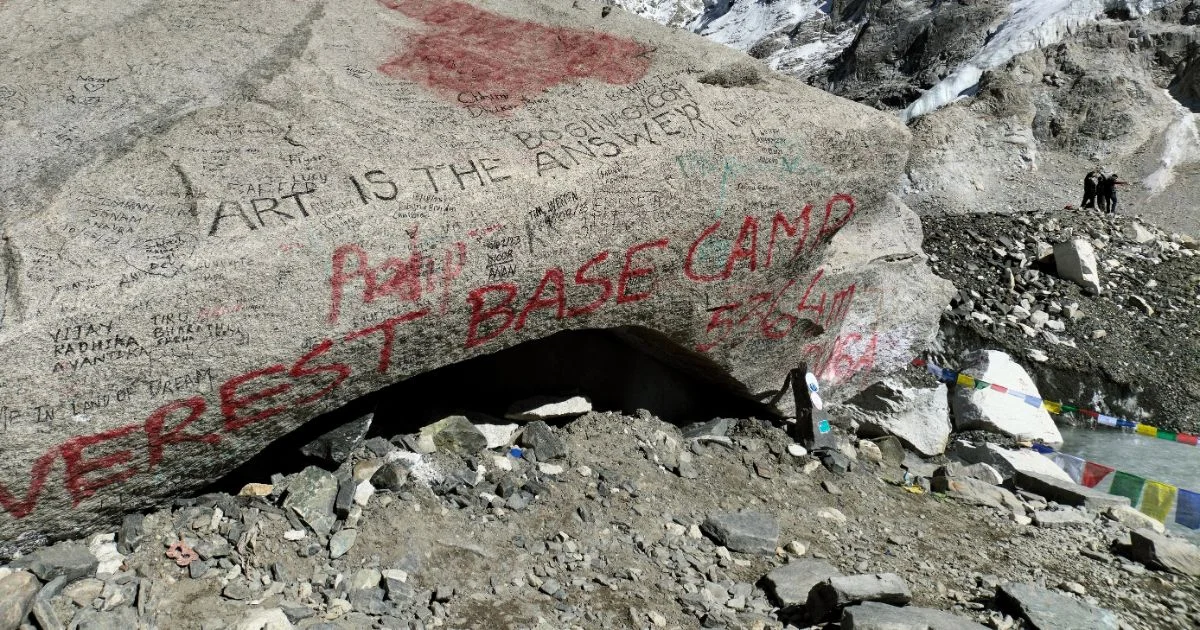
Glacial Lake Outburst Flood Risks
As the Khumbu Glacier retreats, it creates depression zones that fill with meltwater. While most lakes remain small, some grow large enough to threaten downstream communities. Glacial Lake Outburst Floods (GLOFs) can devastate villages with little warning.
The Imja Lake, formed by a tributary glacier, exemplifies these risks. Government agencies and international organisations have installed early warning systems and constructed drainage channels to reduce flood dangers. Similar monitoring extends to other potentially dangerous lakes throughout Sagarmatha National Park.
Ecosystem Disruption and Species Migration
Changing glacier behaviour affects entire ecosystems. Alpine plant communities face habitat loss as suitable temperature zones shift upward faster than slow-growing species can migrate. Some endemic plants may face extinction if they cannot adapt quickly enough.
Wildlife populations also experience stress from changing conditions. Snow leopard prey species like blue sheep must travel farther to find suitable grazing areas. Himalayan tahr face increased competition for diminishing high-altitude habitats.
Community and Conservation Responses
Local Sherpa communities have partnered with conservation organisations to monitor environmental changes around the Khumbu Glacier. Community-based monitoring programmes train local residents to collect scientific data while maintaining traditional livelihoods in this region in Nepal.
The national park in the Khumbu authorities implement adaptive management strategies inside the Sagarmatha National Park, including waste reduction programmes, sustainable tourism policies, and habitat restoration projects. These efforts aim to minimise human impacts while supporting local communities dependent on glacier-fed ecosystems in the park in the Khumbu region.
International cooperation supports conservation efforts. Nepal's government works with neighbouring countries and global organisations to address transboundary environmental challenges. Climate change requires coordinated responses that transcend political boundaries.
Trekking and Glacier Access
Planning Your Khumbu Glacier Adventure in Nepal
Planning your Nepal trekking adventure requires understanding the best time to visit this remarkable glacier system. To access the Khumbu Glacier requires careful preparation and proper permits. TIMS (Trekkers' Information Management System) cards and Sagarmatha National Park entry permits are mandatory for all visitors. These documents help authorities track trekkers and provide emergency assistance when needed.
The optimal trekking season runs from March to May and September to November. Spring offers clear mountain views and blooming rhododendrons, while autumn provides crisp visibility and stable weather. Winter brings extreme cold but fewer crowds, while monsoon season (June-August) creates dangerous conditions with frequent clouds and rain.
Altitude acclimatisation is crucial for safe glacier viewing. Most trekkers follow gradual ascent profiles, spending nights at Namche Bazaar (3,440m), Tengboche (3,867m), and Dingboche (4,410m) before reaching Everest Base Camp (5,364m). This schedule allows proper physiological adaptation to decreasing oxygen levels.
Highlights Along the Classic Route 4539
The famous Everest Base Camp trek to Khumbu Glacier begins at Lukla Airport (2,845 m), one of the world's most dramatic landing strips carved into a mountainside. From Lukla, the trekking trail follows the Dudh Koshi River through pine forests and Sherpa villages in this region of Nepal, gradually ascending toward higher elevations.
The main route to the glacier provides multiple access points for visitors to encounter the Khumbu glacier system. Multiple trekking routes provide access to different viewpoints around the glacier. The main route to the glacier begins in Namche Bazaar, the Sherpa capital, which provides the first spectacular glacier views from the Everest View Hotel. This famous lodge offers panoramic vistas of Everest, Lhotse, and the glacier system while serving as a crucial acclimatisation stop.
Tengboche Monastery presents arguably the trek's most photogenic location. The monastery's dramatic position inside the Sagarmatha National Park offers unobstructed views of the Khumbu Glacier flowing from Everest's base. Many trekkers attend morning prayers here, combining spiritual experience with mountain appreciation.
From Lobuche (4,940 m), dedicated trekkers reach Gorak Shep before approaching Everest Base Camp, where they encounter the Khumbu glacier up close. The final approach crosses lateral moraines and glacier-fed streams, providing intimate contact with the ice environment that shapes this entire ecosystem.

Advanced Glacier Viewing Options
Experienced trekkers can ascend Kala Patthar (5,545 m) for supreme glacier photography. This rocky summit at the top of the glacier system offers 360-degree views of the entire Khumbu Glacier system, including the infamous Khumbu Icefall in remarkable detail. Sunrise from Kala Patthar ranks among the Himalayas' most spectacular experiences and shows how the glacier makes the landscape uniquely dramatic.
The Gokyo Lakes trek provides alternative glacier perspectives from the Cho La Pass (5,420 m). This high-altitude crossing offers dramatic views across multiple glacier systems while avoiding Everest Base Camp crowds. The turquoise Gokyo Lakes, fed by glacier melt, create stunning foreground elements for mountain photography.
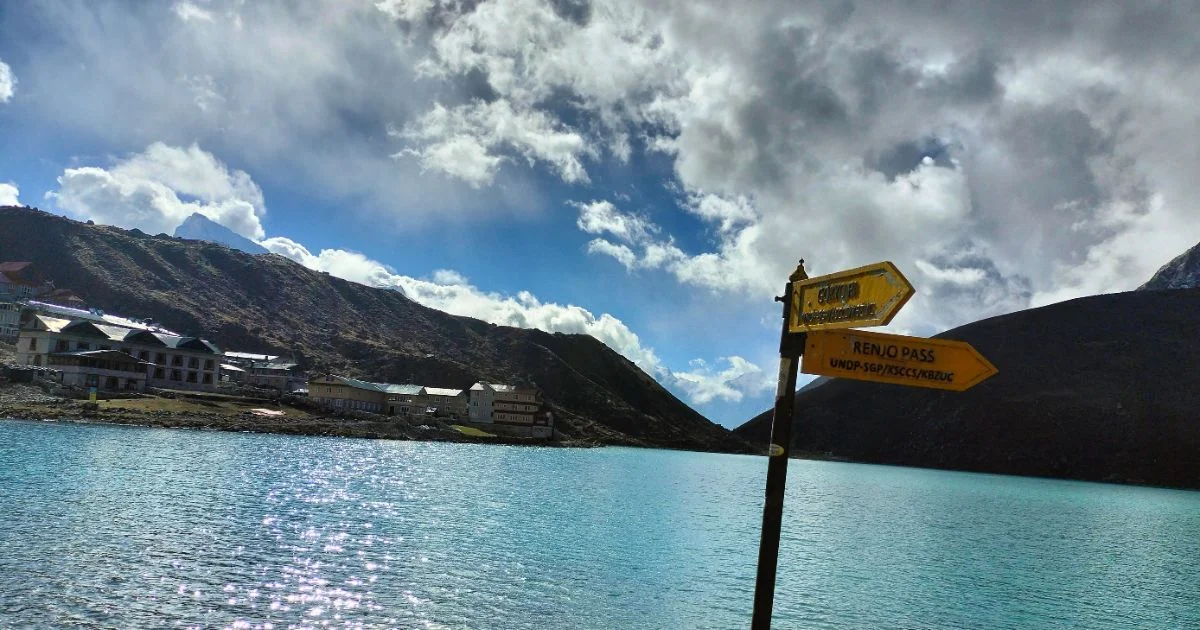
Responsible Glacier Observation Practices
Leave No Trace principles are essential in this fragile environment. Pack out all waste, stay on designated trails, and respect wildlife habitat. The Khumbu Glacier ecosystem cannot absorb impacts from careless visitors.
Maintain safe distances from active ice formations. The Khumbu Icefall melts and moves constantly, creating serious hazards for unauthorised access. Professional mountaineering expeditions use fixed ropes and experienced guides to navigate through active ice zones.
Photography ethics matter in sacred landscapes. Ask permission before photographing Sherpa people or religious sites. Many locations hold spiritual significance that transcends scenic beauty. Respectful behaviour ensures continued access for future generations.
Support local communities by hiring Sherpa guides, staying in family-run teahouses, and purchasing locally made crafts. Tourism revenue helps fund conservation programmes while providing sustainable livelihoods for mountain communities.
Book your expertly guided Khumbu Glacier trek with Nepal Everest Base Camp Co.!
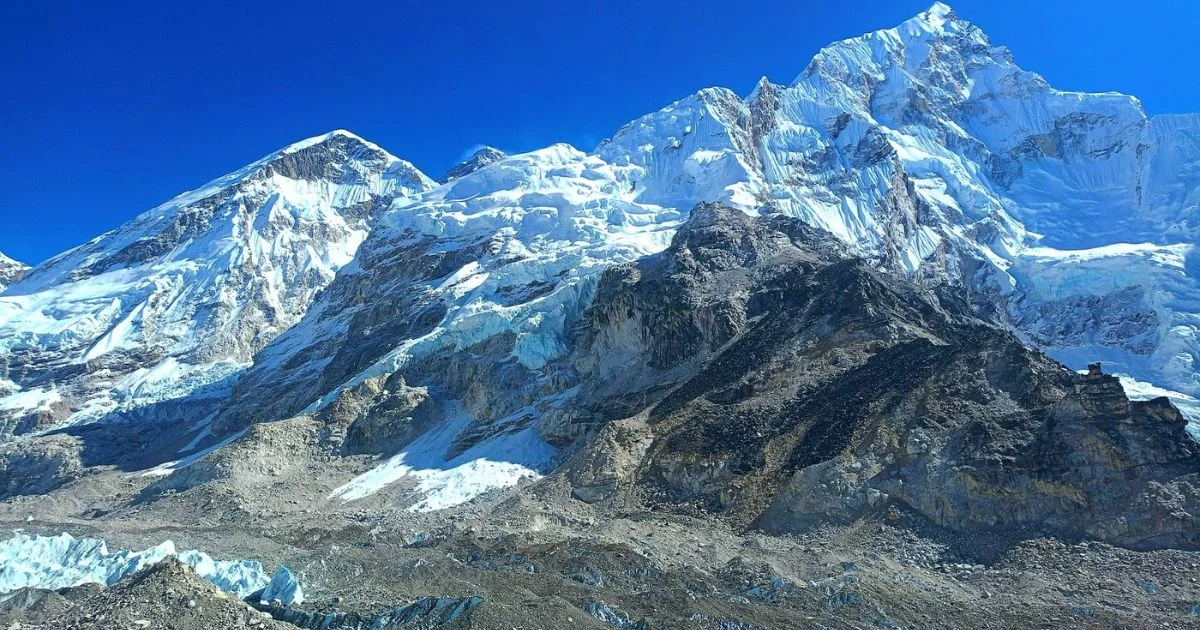
Frequently Asked Questions
What makes the Khumbu Icefall so dangerous?
The Khumbu Glacier is followed by several interconnected ice systems that flow through the Everest region. This glacier starts from the Western Cwm and creates a complex network that makes the region unique in terms of ice formation patterns. The Khumbu Icefall flows over a steep rock step, creating massive seracs (ice towers) that shift unpredictably. These ice blocks can collapse without warning, making it one of Everest climbing's most hazardous sections. The icefall moves roughly one metre daily, constantly changing its configuration and creating new crevasses.
How fast is the Khumbu Glacier retreating?
The Khumbu Glacier has retreated approximately 400 metres since 1960, with current retreat rates averaging 18 metres annually. However, retreat rates vary significantly year to year (8-35 metres) depending on climate conditions. The glacier also thins vertically by 0.5-1.5 metres per year in most sections.
What wildlife might I see near the Khumbu Glacier?
Sagarmatha National Park hosts diverse wildlife, including snow leopards, red pandas, Himalayan tahr, and blue sheep. Bird species include the Himalayan monal (Nepal's national bird), blood pheasants, and choughs. However, wildlife sightings require patience and luck, especially for elusive species like snow leopards.
How does climate change affect the Khumbu Glacier?
Rising temperatures accelerate glacier retreat, while changing precipitation patterns alter snow accumulation. Minimum temperatures have increased 0.8°C per decade since 1975, reducing freezing days necessary for glacier maintenance. These changes create glacial lakes that may pose flood risks to downstream communities.
What permits do I need to visit the Khumbu Glacier?
All trekkers require TIMS (Trekkers' Information Management System) cards and Sagarmatha National Park entry permits. These documents help authorities provide emergency assistance and track visitor numbers for conservation purposes. Permits are available in Kathmandu or Namche Bazaar.
When is the best time to trek to Khumbu Glacier?
Optimal trekking seasons are March-May and September-November. Spring offers blooming rhododendrons and warming temperatures, while autumn provides crystal-clear mountain views and stable weather. Winter brings extreme cold but fewer crowds, while monsoon season (June-August) creates dangerous conditions.
How long does it take to reach the Khumbu Glacier?
The standard trek from Lukla to Everest Base Camp takes 12-16 days, including proper acclimatisation stops. Most itineraries include rest days at Namche Bazaar and Dingboche to prevent altitude sickness. Rushing increases health risks and reduces enjoyment of this spectacular landscape.
Can I see the Khumbu Glacier without climbing Everest?
Yes! Trekkers can view the Khumbu Glacier from multiple locations without technical climbing. Everest Base Camp (5,364 m) offers close glacier access as a distinctive feature of the Everest region, while Kala Patthar (5,545 m) provides superior photography angles. The Everest View Hotel near Namche Bazaar offers glacier views with comfortable accommodation in this park in the Khumbu region.
How do Sherpa people view the Khumbu Glacier?
Sherpa communities consider the Khumbu Glacier sacred, believing it hosts protective mountain deities. Traditional practices include puja ceremonies seeking permission from spirits before major expeditions. Sherpas maintain spiritual connections to glaciers while adapting to tourism-based economies in this region in Nepal known as the Mount Everest region.
What conservation efforts protect the Khumbu Glacier?
Conservation initiatives include glacier monitoring programmes, waste reduction campaigns, and sustainable tourism policies. Nepal Everest Base Camp Co. collaborates with local communities and international organisations to support research and protect this fragile ecosystem. Visitor fees fund park management and conservation projects.
Experience Nepal's Greatest Natural Wonder
The Khumbu Glacier in Nepal represents more than a trekking destination - it's a living laboratory where nature's power creates and destroys landscapes on timeframes both geological and immediate. This ancient ice river connects us to climate patterns spanning millennia while demonstrating our planet's vulnerability to rapid change.
Through responsible trekking with Nepal Everest Base Camp Co., you become part of conservation efforts that protect this remarkable environment for future generations. Our local expertise ensures safe, culturally sensitive experiences that benefit Sherpa communities while providing unforgettable encounters with one of Earth's most dramatic landscapes.
The glacier awaits your respectful visit. Every step toward its terminus reveals new perspectives on the delicate balance between human adventure and natural preservation. Start planning your Khumbu Glacier adventure today and join the ranks of travellers who return home with profound appreciation for our planet's wild places.
Ready to witness the ice highway that shapes the roof of the world? Contact our team of glacier experts and begin your journey to the heart of the Himalayas.
